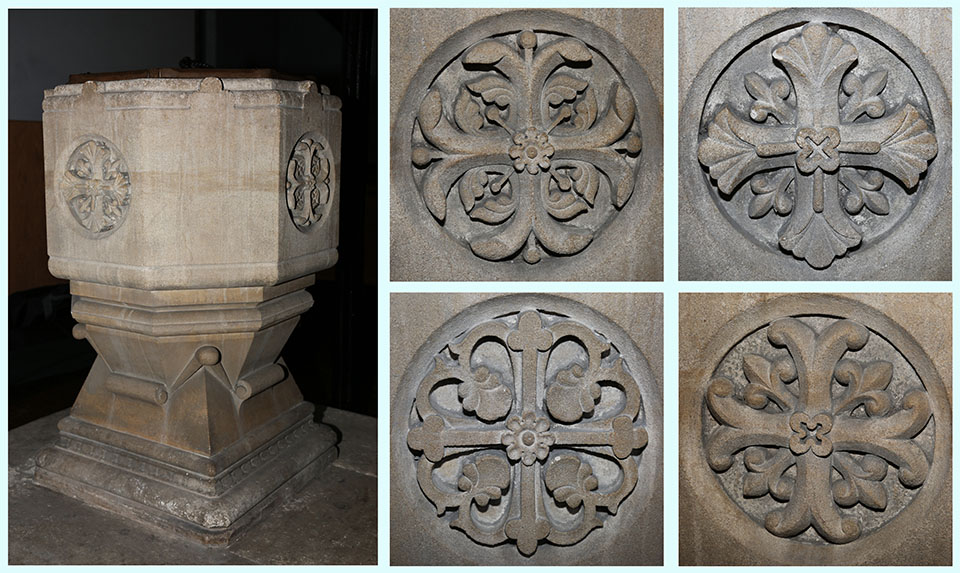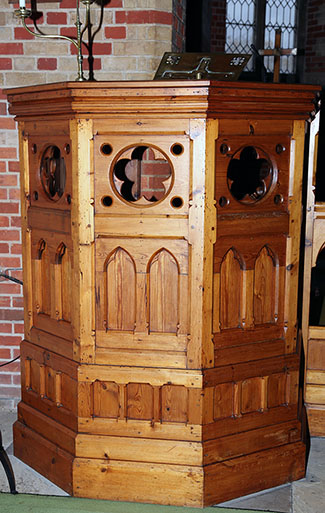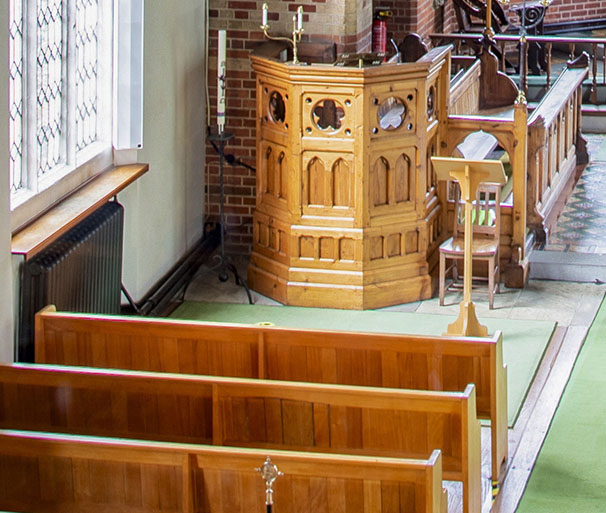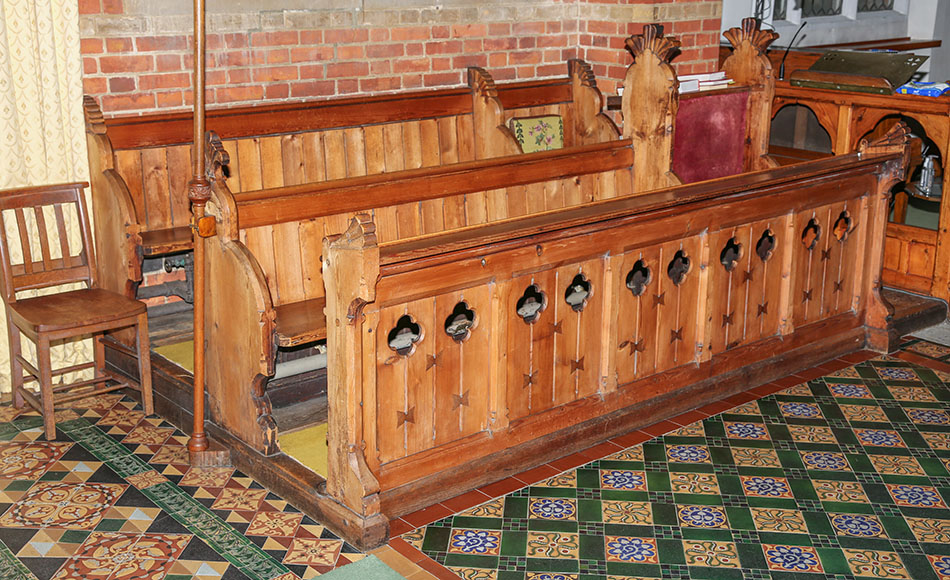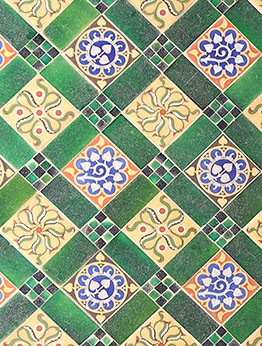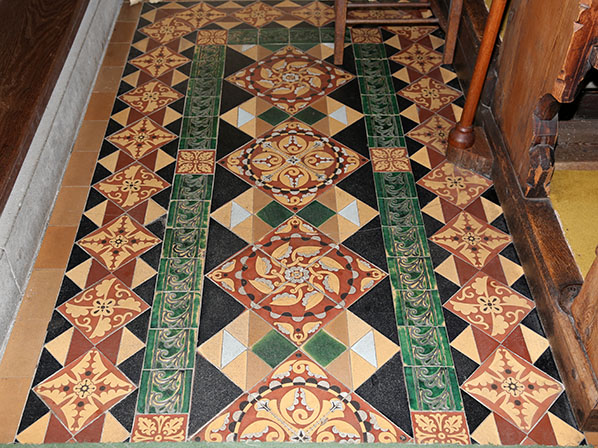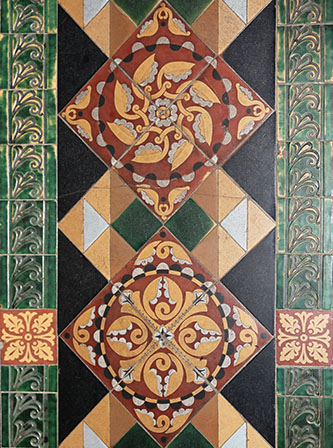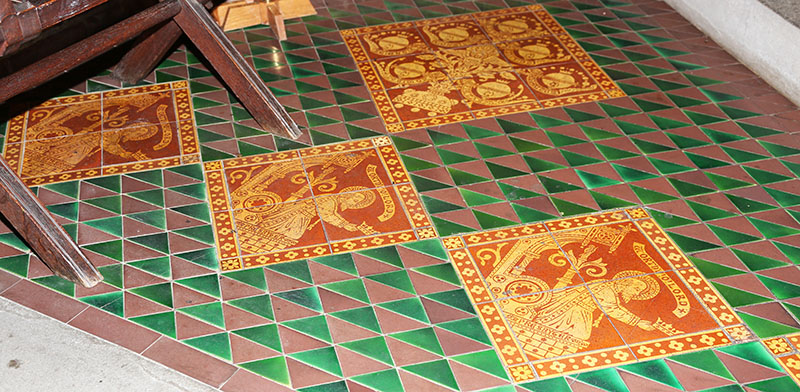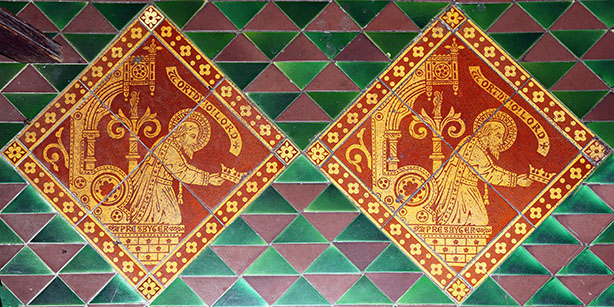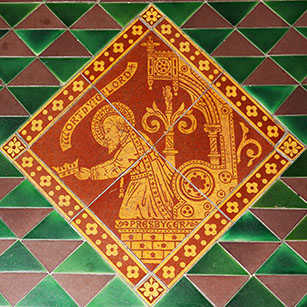These are just three of the elders casting their crowns. They all face the centre, so the one on the right is from the right hand side of the Sanctuary.
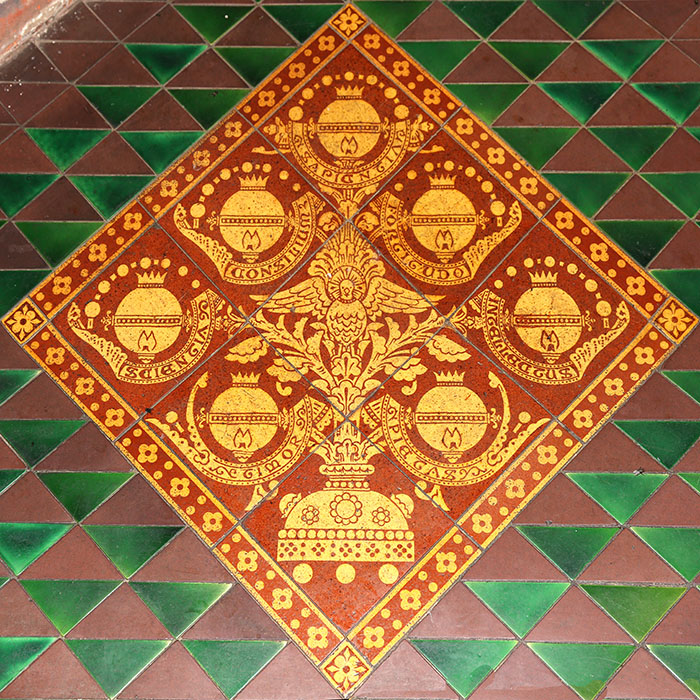
This is one of the two panels that show the seven lamps burning, all branched off a stand, with the Dove of the Holy Spirit in the centre. Each lamp is named with one of the SEVEN GIFTS OF THE HOLY SPIRIT.
There is no really definitive list in the Bible, but there are a number of possibilities in Revelations and Isaiah. However in 1871 the generally accepted seven qualities (of which six are listed in Isaiah 11:2, excluding piety) were chosen for these tiles, and they are as follows, working clockwise from the left hand side of the base:
TIMOR (fear of the Lord), SCIENTIA (knowledge), CONSILIUM (counsel or judgement), SAPIENTIA (wisdom), FORTITUDO (courage or might), INTELLECTUS (understanding), PIETAS (piety).
Go up page to INDEX
Other Items - Royal Arms, Hatchment
Royal Arms of King George IV.
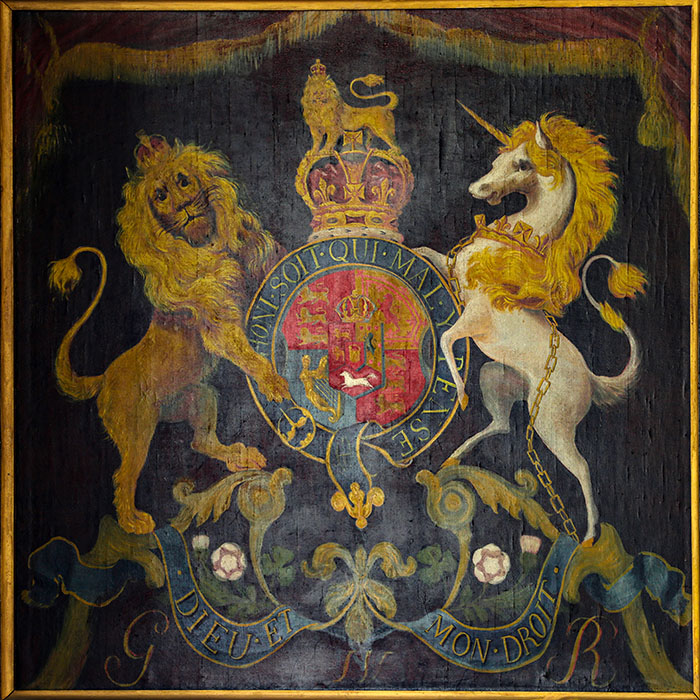
The Royal Arms of King George IV (1820-1830) which are in a frame 5 feet (1.5 metres) square, hung on the W wall of the S Transept, now known as the Lady Chapel.
Some literature about St John's church expresses doubt about the origin of the Royal Arms. However, the Arms are those in use from 1816 to 1830, and they are marked "George IV R" (1820-30). That matches perfectly with the date that the church was built, and I would expect them to have been there when it was consecrated in 1825.
Since 1660 and the Restoration of the Monarchy, it was customary for all churches to have the Royal Arms displayed, although it was never actually obligatory by law. It was not until the middle of the 19th Century that it became more common for Royal Arms to be removed from churches. That coincided with the many Victorian restoration schemes, when fittings such as Royal Arms would be removed, put in store, and did not always get re-installed after work was completed. Once some churches were not admonished for not displaying them, then others would not worry about displaying (or even keeping) their Royal Arms.
Actually, in the case of Lacey Green's church, I would be very certain that all the "Members of the Nobility, Clergy and Gentry" who were the original benefactors of the church, would actually insist that the Royal Arms were displayed in the new church to which they had contributed. With many of them having their own Arms displayed in the East window at the time, I can well imagine that the Royal Arms could have been hung directly above that East window.
It would undoubtedly be the principle of having the Royal Arms that would have mattered, whatever people's own opinions of King George IV and his extravagances.
Hatchment.
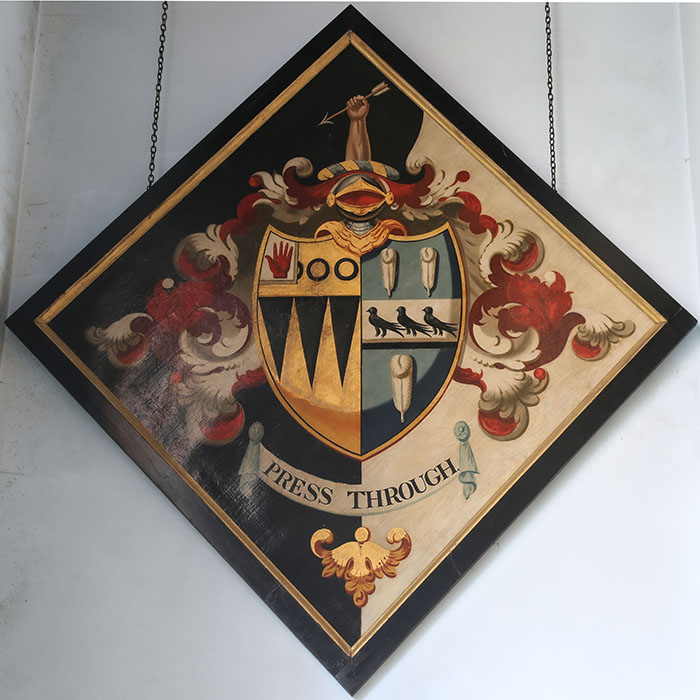
This Hatchment now hangs in the N Transept, the part originally occupied by the private gallery of Lord George Augustus Henry Cavendish
This is often stated to be the hatchment of Sir William Young, 4th Baronet. He was born in 1806 but died in 1842, having been an MP for Buckinghamshire since 1835. He had married Caroline Norris, a daughter of John Norris who had designed St John's church.
However, the definitive books on Hatchments in Britain state that it is for Sir William Young the 3rd Baronet. He was born c1778 and married Anna Louisa Tufnell of Essex in 1805. On the hatchment his wife is represented by 3 ostrich feathers and 3 black martlets, which represent the Tufnell family. The 3rd Baronet died on 3rd November 1824, 8 months before the Consecration of St John's church. He lived at Bradenham House, and his son the 4th Baronet lived at North Dean House.
Go up page to INDEX
1820s Benefactors
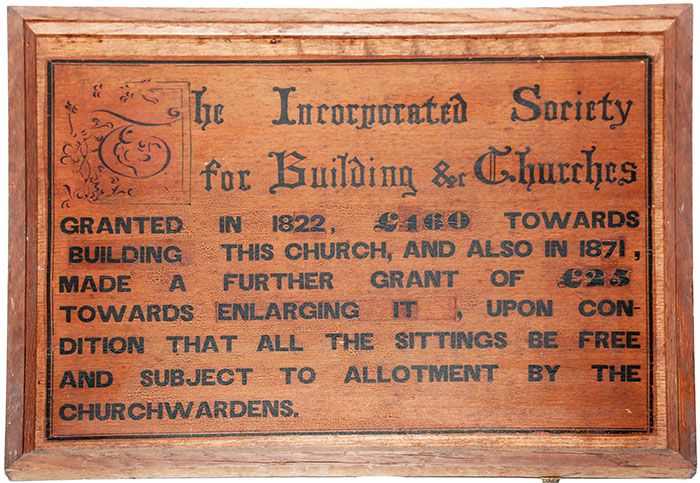
This board in the vestry records the important donation of £460 made towards the original church in 1822, and the rather smaller figure of £25 towards the addition of the Chancel in 1871. The Society had only been established four years earlier in 1818. It is now known as the Incorporated Church Building Society, and since 2013 has been part of the National Churches Trust.
A very extensive list was published at the time which showed how successful the appeal had been in attracting donations from a very wide area, and from a large number of Members of the Nobility, Clergy and Gentry that the appeal had been specifically aimed at. The published list gave the precise amounts of all the donations of £5 and over, but those details have not been included here.
The following list records 17 donations from local landowners towards the funds to build the church in the 1820s. They ranged from £5 to £44.
Rt Hon Lord George Augustus Henry Cavendish, later Earl of Burlington
Rt Hon George Robert Hobart-Hampden, Earl of Buckinghamshire
Rt Hon Thomas Lord Viscount Hampden
Rt Hon John Lord Viscount Hampden
Sir Scrope Bernard Morland Baronet MP
Sir William Lawrence Young Baronet MP
Messrs Weller, Amersham
Mrs Stone, Lacey Green
Mrs Shard, Lacey Green
Matthew Raper, Wendover
A Welland, Loosley Row
Rev Richard Meade, Horsenden and Princes Risborough
Rev Richard Lendon
Rev Isaac King
Thomas Wethered, Great Marlow
A E Biddle and Robert Wheeler, Wycombe
Robert Wheeler
Mr James Grace
The following list records 68 donations from other paople each of whom gave between £5 and £41, with the exception of one person who gave £120.
Hon and Rt Rev George Pelham, Bishop of Lincoln
His Grace John, Duke of Bedford
His Grace Richard Nugent Grenville Chandos Temple, Duke of Buckingham and Chandos
Most Hon Charles Ingoldsby, Lord Marquess of Winchester
Rt Hon John William Earl of Bridgewater, of Ashridge
Rt Hon Catherine Anne, Countess-Dowager of Bridgewater
Rt Hon Philip Earl of Chesterfield
Rt Hon Montagu Earl of Abingdon
Rt Hon Rt Hon Henry Earl of Dartmouth
Rt Hon George Lord Kenyon
Rt Hon George Lord Boston
Rt Hon William Wyndham Lord Grenville, of Dropmore House
Rt Hon Thomas Atherton, Lord Lilford
Rt Hon Charles George Spencer, Lord Arden
Rt Hon Lord Gambier
Rt Hon Lord Francis Almaric Spencer, Baron Churchill
Rt Hon Sir Robert Peel
Rt Hon Richard Ryder
Rt Hon John Sullivan, of Richings Park
Hon Philip Pusey
Hon and Rev C J Perceval, Rector of Calverton
Rev Sir George Lee, Baronet, of Hartwell House
Sir John Aubrey, Baronet, of Dorton House
Thomas Baring, Baronet MP
Sir Robert Bateson Harvey, Baronet, of Langley
Sir George Nayler, Knight Garter King-at-Arms, of Bradenham
John Norris, of Hughenden House, Rev Robert Eyres Landor, of Hughenden
J Watts Russell MP
Robert Williams MP
John Camden Neild, of Bledlow
Geoffrey Purefoy Jervoise MP, of Hernards, Hampshire
Mrs Purefoy Jervoise, of Shalstone
T T Drake MP, of Amersham
Rev John Drake, Rector of Amersham
J Drummond, of Denham
John Penn, of Stoke Poges
Samuel Smith MP, of Wendover
Rev Christopher Rigby Collins, of Risborough
Rev T Beckett Turner, of Wotton
Rev Edward Vansittart Neale, of Taplow
Rev John White, of Hardwick
Rev Robert Wetherell, of Newton Longville
C Chester, of Chicheley
Mrs Clowes, of Delaford Park Iver
Thomas Tindal, of Aylesbury
John Newman
Rev Mr Hamilton, Rector of Ellesborough
Joshua Watson, of Clapton
Mrs Duppa, of Homerton
Messrs Praed and Co, Bankers of Fleet Street
Lady Carr, of Ealing
Lady Mordaunt, of Harrow
Rev George Butler, Headmaster of Harrow School
Rev Charles P Burney, of Greenwich
The Tre=sutees of Lord Crew's Charity
Mrs Sheppard, of Amport Hampshire
Mrs Waldo, of Worthy Hampshire
Mrs Long, of Winchester
Very Rev Dean and Chapter of Rochester
Robert Forster, of Warwick
President and Fellows of Magdalen College, Oxford
Warden and Fellows of All Souls College, Oxford
Master and Fwellows of Balliol College, Oxford
Rev William Cleaver, of Wanlip
Rev Dr Ashurst
Fiennes Wykeham Martin, of Leeds Castle Kent
Rev William Hughes, Rector of Bradenham
Rt Rev John Lord Bishop of Lincoln
There were around another 200 benefactors who gave sums of up to £5.
The "purchasing value" of a £5 donation in the 1820s would need over £400 in 2020.
Go up page to INDEX
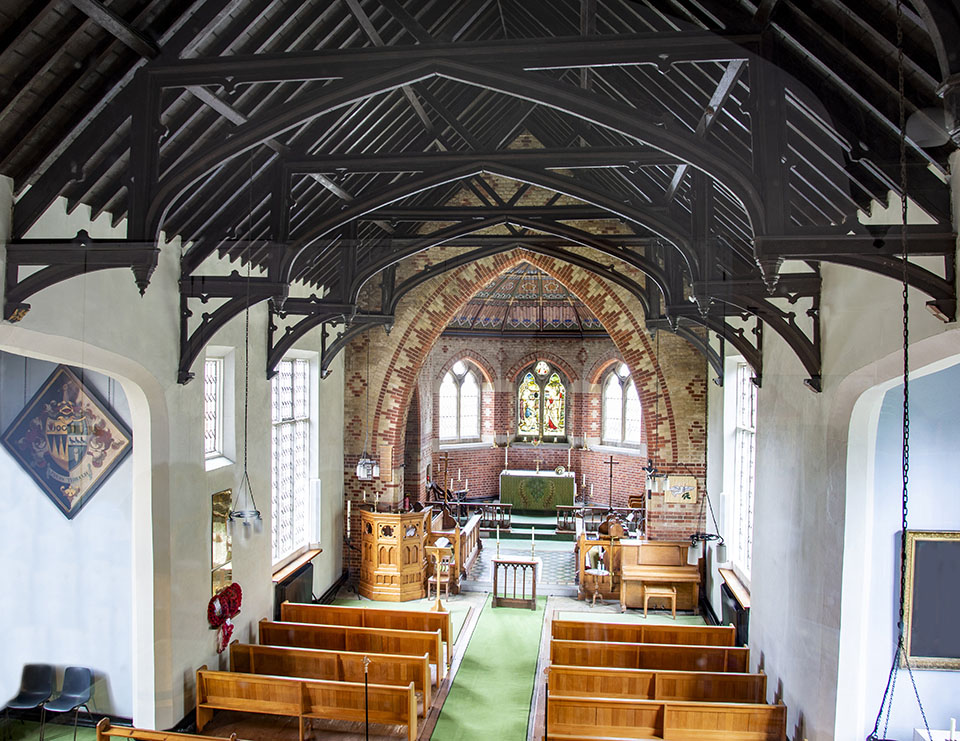
The interior, seen from the West Gallery.
Go up page to INDEX
Historic Churches of Buckinghamshire
All photographs by Michael G Hardy unless stated otherwise
©2017-2025 Michael G Hardy

